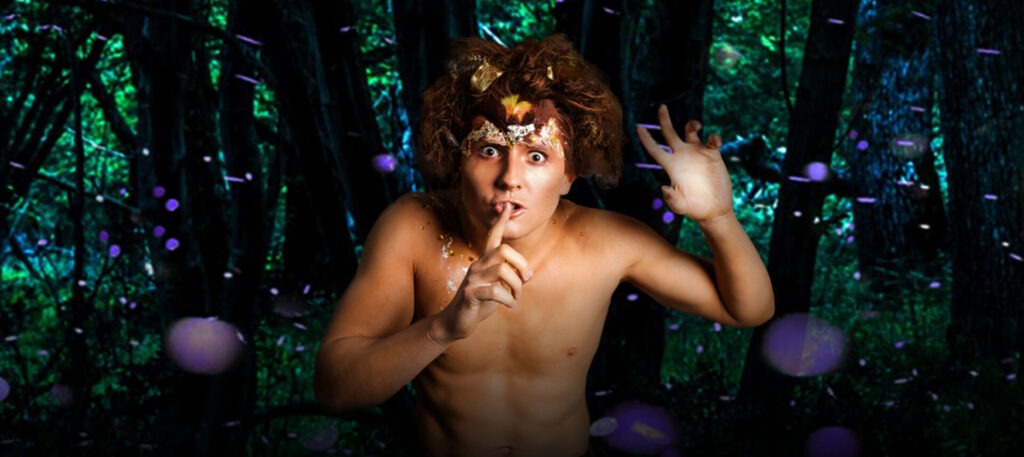
‘A Midsummer Night’s Dream’ // Australian Shakespeare Company
‘A Midsummer Night’s Dream’ was delightful.
The Australian Shakespeare Company (ASC) is Australia’s largest independent theatre company, bringing The Bard’s plays outside since 1989. This isn’t their first production of Shakespeare’s most popular comedy in the Botanic Gardens: most recently the ASC performed A Midsummer Night’s Dream in 2021 and 2022, before taking a break from the text with last year’s The Wind in the Willows.
According to ASC Artistic Director Glenn Elston OAM, this year’s return ‘reimagine(s) A Midsummer Night’s Dream in a way that makes it even more accessible and in step with today’s world.’ Indeed, the action starts (at dusk) with the addition of an entirely modern scene. The comic characters who form the amateur troupe of actors (or ‘mechanicals’) in the play come onstage, spell out the setting (the impending wedding of the Duke and Duchess of Athens, and their rehearsals of a play within this play as nuptial entertainment), and do some housekeeping. Four-hundred-year-old humour doesn’t tend to date well. Whenever the play returns to their subplot, modern jokes have been inserted to liven up their now rather unfunny comic business. The jokes contribute to a pantomime feel in these scenes that lands well with the audience.
In his director’s notes, Elston also points to ‘some welcome gender changes to the casting.’ Most notable (and effective) is the decision to gender flip the character of Egeus, who is Hermia’s controlling father in the original text. This makes the first scene of the play, where Egeus is unhappy with her daughter’s love match with Lysander and gets the Duke of Athens involved to attempt to force her to go through with an arranged marriage to Demetrius, far more tolerable to a modern audience than if the gender dynamic of a controlling father and a ‘disobedient’ daughter had been retained.
There are other, subtler touches throughout that modernise and alter the meaning of the text without adding to or changing the original script. For example, the Duke (Theseus, played with real gravitas by Hugh Sexton) literally and figuratively rolls his eyes at Egeus, and enforces the law that Hermia must follow her mother’s wishes with visible and comic reluctance.
All the performances of the leads are strong, though award-winning actor Elizabeth Brennan (who most recently appeared in the Disney+ series The Clearing alongside Miranda Otto and Guy Pearce, and also plays Egeus,) steals the show with her portrayal of Bottom (the least bad of the actors in the Mechanicals). Close second is comedy legend Syd Brisbane (of countless stage and TV credits) who relishes the best role in the play, the magical sprite ‘Puck’, to mischievous perfection.
Because it is a Shakespeare comedy, the plot will either be known to you already, or thoroughly confusing in summary: the lovers, Hermia and Lysander, elope into the woods where the bulk of the action of the play occurs, but not before telling their friend Helena (who is in love with Demetrius). All four Athenian friends / lovers end up there pursuing their crossed purposes, as do the Mechanicals, to rehearse their play in peace. To progress (and ultimately resolve) the conflict of the characters already introduced, Shakespeare throws in the quarrelling King and Queen of the wood fairies, Oberon (also Hugh Sexton) and Titania. Oberon tasks his right-hand sprite ‘Puck’ with using a magical flower which makes sleeping people fall in love with whomever or whatever they first set their eyes on to embarrass Titania (and while he’s at it, mess with the lives of the Athenian mortals). Mix-ups and confusions ensue, before Oberon magically corrects everything, and believing it was all a dream, the Athenians all marry the right person.
It is a technically delightful production that takes advantage of its setting. Lighting effects utilise trees in the garden as a backdrop. Karla Erenbots’ costumes are a marvelous standout; in particular the glimmering dresses of Titania’s fairies, incorporating in-built lighting as well as glimmering with reflected stage-light in the darkness, and the counterposing costumes of Oberon and Puck, a leafy patchwork of russet tones. The costumes of the mortal characters are individually all perfect for the characters, albeit a bit thematically confusing taken together – the play has the Duke’s attendant in a traditional Greek outfit in the same scene as the Duke and Duchess dressed in modern formal-wear. Shortly afterwards, the the young Athenians appear in the woods in hyper-coloured fluorescent eighties garb different to the style of the clothes they wore in the daytime world, though perhaps this symbolises their entry into the magical world of the woods.
Overall, this is a delightful production of A Midsummer Night’s Dream, replete with some really impressive physical acrobatics and dance to wring all the entertainment possible out of the text.
‘A Midsummer Night’s Dream’ performs until Sunday, 11 February 2024 at Royal Botanic Gardens’ Southern Cross Lawn. For more information visit their website.






